
197
VA-76 – MIDI in general
14.1 MIDI in general
MIDI connectors
MIDI messages are transmitted and received using
three connectors and special MIDI cables:
MIDI IN— This connector receives messages from
other MIDI devices.
MIDI OUT— This connector transmits MIDI mes-
sages generated on your VA-76
MIDI THRU— This connector “echoes back” all
MIDI messages received via MIDI IN
Channels
MIDI can simultaneously transmit and receive mes-
sages on 16 channels, so that up to 16 instruments can
be controlled. Nowadays, most instruments –like your
VA-76– are multitimbral, which means that they can
play several musical parts with different sounds.
That concept is not difficult to understand. Just think
of your VA-76: it is equipped with an Arranger capable
of playing the drums, the bass, and up to six accompa-
niment parts, while at the same time allowing you to
play up to seven Keyboard parts.
MIDI data types
The most important aspect of the MIDI standard is
that it allows one instrument to tell another when to
play a note, for how long, and how strongly it should
be played.
Other aspects of a musical performance include mod-
ulation (vibrato), Pitch Bend (bending), volume, Pan-
Pot, etc.
Yet another group of MIDI messages is used to tell the
receiver when to select another sound and which
sound to select. These messages are called Bank Select,
and Program Change. In fact, these are the messages
that are automatically recorded at the beginning of
each Style division and written to a User Program so
that you can recall the Tone selection for all available
parts simply by selecting a User Program. Program
Change and Bank Select messages also allow you to
select User Programs, Styles, and Drum Sets.
Still other MIDI data allow you to synchronize two
MIDI instruments so that they start and stop at the
same time and run at the same tempo.
MIDI messages used by the VA-76
The way a device responds when it receives MIDI mes-
sages (i.e. how it produces sound, etc.) depends on the
specifications of that device. If the receiving device is
not able to perform the function specified by the
incoming message, the musical result will not be what
you expected. What it comes down to is this: there are
several levels of MIDI compatibility, and not all MIDI
compatible instruments understand (i.e. receive) all
existing MIDI messages.
Note: MIDI messages for which reception capability is
required by the GM system (level 1) are marked by a * sign.
Note messages *— These messages convey notes
played on the keyboard. They include the following
information:
On many instruments (such as your VA-76), a note-on
message with the velocity value “0” is used to signal
the end of a note (i.e. velocity value “0” effectively
functions as note-off message).
Pitch Bend *— This message conveys the position of
the Bender lever (or pitch bend wheel). The pitch will
change when this message is received.
Bank Select (CC00 and CC32), Program Change *—
On the VA-76, these messages are used to select Tones,
Styles, and User Programs. By using Bank Select mes-
sages (which are in fact control change messages), an
even wider variety of memory locations can be
selected. Control change messages were added when it
became clear that the maximum number of sounds
selectable using Program Change messages (128) was
no longer sufficient to access all sounds of a given
instrument.
Note: Do not forget to send a Program Change message
after a Bank Select message because sending only Bank
Select messages does nothing whatsoever. The right order for
sending these messages is (pay attention to the CPT values):
1.1.0 Bank Select CC00 + value
1.1.1 Bank Select CC32 + value (0, 1, 2, 3, or 4)
1.1.2 Program Change
On the VA-76, CC32 messages are used to select the
Tone Map: “0” (don’t leave current Tone Map), “1”
(SC-55 mode), “2” (G-800), “3” (G-1000 or
EM-2000), or “4” (VA-76).
14. MIDI
Note number A number describing the note corresponding
to the key you pressed or released.
Message Explanation
Note-on A message signalling that you pressed a key
(i.e. “start playing now”).
Note-off A message signalling that a key was released.
Velocity A value describing how strongly you pressed
a key.
VA-76.book Page 197 Friday, January 12, 2001 12:35 PM


















